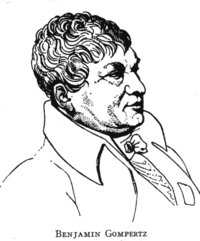Benjamin Gompertz facts for kids
Quick facts for kids
Benjamin Gompertz
|
|
|---|---|

woodcut, Welcome Trust
|
|
| Born | 5 March 1779 London, England
|
| Died | 14 July 1865 (aged 86) London, England
|
| Nationality | British |
| Known for | Gompertz distribution Gompertz-Makeham law of mortality Gompertz constant |
| Spouse(s) |
Abigail Montefiore
(m. 1810) |
| Children | 3 |
| Scientific career | |
| Fields | Mathematics Astronomy |
| Institutions | London Stock Exchange Alliance Assurance Company Royal Astronomical Society |
Benjamin Gompertz (born March 5, 1779 – died July 14, 1865) was a smart British man. He taught himself math and became an actuary. An actuary is someone who uses math to figure out risks for things like insurance. He was also a member of the important Royal Society. Gompertz is famous for his "Gompertz law." This law helps understand how people's risk of dying changes as they get older. He published it in 1825. His brothers were Lewis Gompertz, who cared about animal rights, and Isaac Gompertz, a poet.
Contents
Life of Benjamin Gompertz
Benjamin Gompertz was born in London. His family was German Jewish, and his father and grandfather were successful diamond merchants. Because he was Jewish, Benjamin could not go to a university. So, he studied on his own from a young age. He read books by famous scientists like Isaac Newton.
From 1798, he wrote many articles for a magazine called Gentleman's Mathematical Companion. He even won prizes for solving math problems in the magazine. In 1810, Gompertz married Abigail Montefiore. They had three children together.
Benjamin followed his father's wishes and started working at the London Stock Exchange. He joined the Mathematical Society of Spitalfields. Later, he became its president. This society then joined with the Astronomical Society of London. In 1819, he was chosen as a Fellow of the Royal Society. He also became a council member of the Astronomical Society in 1821.
After his only son passed away, Benjamin left the Stock Exchange. He spent all his time studying math. In 1821, a new company, the Guardian Insurance Office, was looking for an actuary. Benjamin wanted the job, but the directors didn't hire him because he was Jewish.
So, his brother-in-law, Sir Moses Montefiore, and his relative Nathan Mayer Rothschild started their own company. It was called the Alliance Assurance Company (in 1824). They hired Gompertz as their actuary. He did a great job managing the company. The government even asked him for advice. He also did calculations for the Army medical board.
In 1848, Benjamin Gompertz retired from his job. He went back to his scientific studies. He was a member of many important learned societies. He also helped create the Society for the Diffusion of Useful Knowledge. Benjamin was a big supporter of Jewish charities. He even created a plan to help poor people, which was later used by the Jewish board of guardians.
Benjamin Gompertz died on July 14, 1865, after a paralytic seizure.
Benjamin Gompertz's Work
Benjamin Gompertz wrote many papers for the Philosophical Transactions of the Royal Society starting in 1806. He also published his own books on math topics like complex numbers. He was a fan of Isaac Newton's old ways of doing math.
Astronomy Contributions
For ten years, Gompertz worked hard with the Astronomical Society. He wrote papers about how astronomical instruments work. He also studied things like the aberration of light and different types of pendulums.
In 1822, he started working with Francis Baily to create tables for the average positions of fixed stars. They stopped this work when another scientist, Friedrich Bessel, published his own detailed star catalogue. However, their efforts helped create a complete list of stars for the Royal Astronomical Society.
The Gompertz Model
Gompertz created new tables to understand how people die. This led him to develop his famous "law of human mortality" in 1825. He first shared this idea in a letter to Francis Baily. His law suggests that a person's ability to resist death gets weaker as they get older.
The math for his model looks like this:  Here, N(t) shows how many people are alive at a certain time t. The letters c and a are constants, which are numbers that don't change.
Here, N(t) shows how many people are alive at a certain time t. The letters c and a are constants, which are numbers that don't change.
This model improved on an earlier idea by Robert Malthus. Insurance companies used Gompertz's model to figure out how much life insurance should cost. Today, this equation, called a Gompertz curve, is used in many areas. It helps to model how things grow over time, especially when growth is slow at the beginning and end. This model has also been expanded into the Gompertz–Makeham law of mortality.
See also
- Population dynamics
- Gompertz distribution
- Gompertz-Makeham law of mortality
- Gompertz constant
Images for kids


